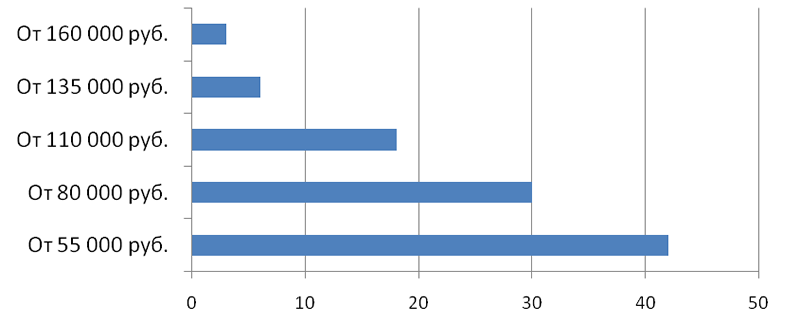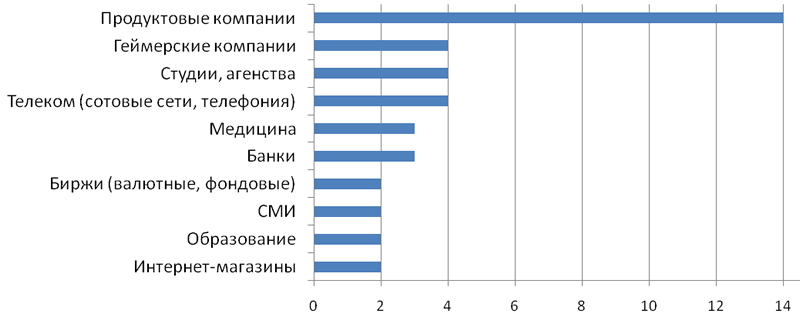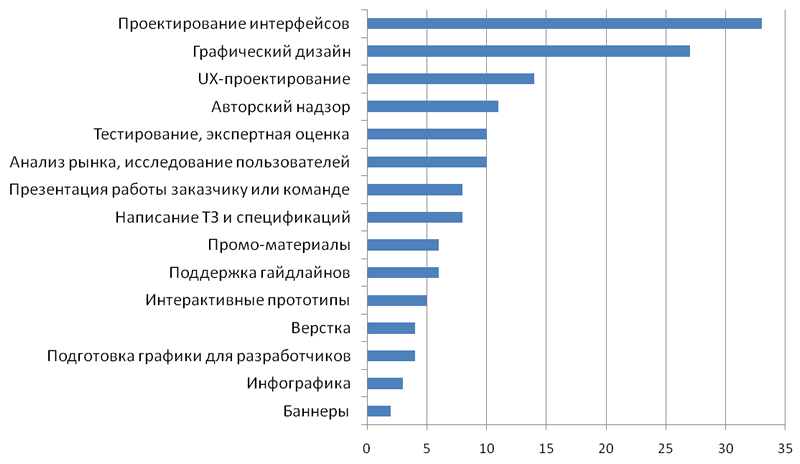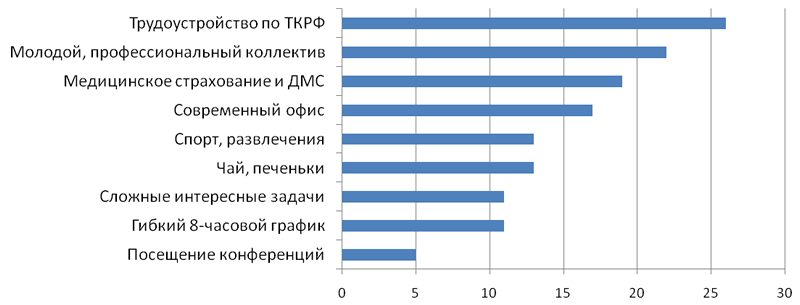Interface Designer: who exactly companies need
In the past few years, the design of interfaces began to gain considerable popularity. Domestic companies, whose business is somehow connected with computers and the Internet, have begun to understand that simply “design” in the sense in which it is used by us is not enough, it is necessary not only beautiful, but also convenient. As a result, we see a considerable number of vacancies with such words in the description, as UX, UI, UCD, usability and stuff like that.
From time to time I had to monitor the labor market in this area. First, to understand what competencies are in demand and what it is worth learning. Then I was looking for a job as a designer, and now I'm helping to look for another one or two to our department.
I have some understanding of who the interface designer is and what companies are expecting from an average specialist, and now I’ve got an idea to do a little research to quantitatively display my observations and share with you.
The article may be of interest primarily to those who are just beginning to master the design of interfaces and web design in order to understand what needs to be learned in order to meet the expectations of the employer. More experienced colleagues may be interested in what the market is now demanding and what skills should be pumped up to stay on the wave. For employers, the article may help determine and more clearly articulate who they really want to hire.
I am doing this kind of research for the first time and do not pretend at all for objectivity and completeness, but I hope that I managed to show the general state of affairs.
')
For the sake of simplicity, in this article I will call designers.
It is also worth noting that all statistics are generated solely on the basis of job descriptions, many things employers imply, but clearly do not indicate, therefore the value of some components may be underestimated.
For comparison, a search for “web designer” gave me 1027 results.
In these cities, many vacancies are repeated as well, so I decided to give relative figures, rather than specific numbers.

Distribution of vacancies in cities of Russia
There are no surprises here. Moscow and St. Petersburg are leading with a very large margin. In the regions, designers are needed, but extremely rarely. The reason in my opinion is that such specialists are needed mainly in product teams that develop web services, applications, and desktop programs (more on this below). And these teams are concentrated mainly in Moscow and St. Petersburg, hence such statistics.
By the way, regional web studios also have designers, but as far as I know, these are isolated cases.

Salary Interface Designer
Product companies are companies whose main business is an Internet project (product). I did not divide them into subcategories, because so very diverse spheres met. The exceptions were games, since this is a separate industry of its own, as well as medicine, which included both Internet-related projects of medical subjects and software for medical devices.
It's nice to see banks working on improving websites, Internet banking and mobile applications among companies. It is also clear that online stores are increasingly beginning to care about the state of the interfaces of their sites.

Distribution of vacancies by activity
Leading, as expected, sites and web applications. Mobile applications are coming on the heels of the web and perhaps novice designers should now pay more attention to mobile applications, and old men start looking in this direction so that in the future they will not remain without a piece of bread.
It is also worth noting the need for designers for specific types of interfaces, such as terminals, car navigation systems, interactive television. I wonder how many people in Russia have adequate experience in such projects?

Distribution of vacancies by platform type
The presence of a portfolio also interests the majority of employers. In the response to the vacancy they are asked to provide from 3 to 10 examples of the best jobs. Many employers talk about the need to perform a test task, and in a couple of vacancies it was even described.
So, from forty vacancies the majority contained the following requirements:

Requirements for designers, described in most vacancies
As we can see, Photoshop continues to be the program number 1 for everything that is related to visualization. Of the prototyping programs, Axure is most often mentioned, but in most cases this is not a strict requirement and you have the right to suggest a replacement. For example, I use Fireworks, which works for both of the above programs.
Among the popular requirements are those that accompany the main work of the designer: knowledge of design methodologies, the ability to communicate with people and “understanding usability”.
Often there is a need to know English. Basically, this is a requirement of representative offices of international companies, or working with foreign customers. In general, the specificity of our work is such that English is at least at the level of reading specials. literature need to know.
It is also interesting that art education turned out to be preferable to technical. At least among those who clearly indicated this.
Understandably, the design of interfaces, most employers directly stated this. I don’t want to argue here whether the designer should be able to draw the final design, but the second line of the diagram gives us the answer to this question. 27 of 40 employers want the designer to not only make prototypes, wirefrmes, sketches, etc., but also draw their final appearance. Moreover, in addition to UX interface design and thinking through the UX, the designer should sometimes be able to draw promotional pages, banners, flyers, icons, and even illustrations. However, in many companies, the designer works in conjunction with a graphic designer.

Main responsibilities of the interface designer
For example, I have often met practice when there is only a designer in the staff, and a graphic designer is temporarily hired on a project so that he draws the main pages and elements, and the designer based on them has already done the final layouts of the other pages. This is where artistic taste and the knowledge of Photoshop comes in handy.
Also, a great advantage will be the experience of layout or at least an understanding of how the web pages are structured, what possibilities and limitations they have.
The last two requirements also apply to technology and both relate to gaming vacancies.

Additional requirements for the designer
Knowing the dislike of it-wren early to wake up, many are ready to move the working day an hour or three ahead.
Someone is ready to take employees to profile conferences and distribute books, someone to pay for the gym and teach English, some lure employees with MacBooks, an “A” class office and free meals.

Working conditions for the designer
1. Designer with graphic design skills
He knows by heart Cooper, Ruskin and Nielsen, knows how to pull information out of people and turns it into a product that is convenient to use, which he can confirm by conducting usability testing. Axure owns Axure and others like him, but he is also ready to draw a layout based on guides and ready-made elements in Photoshop.
2. Graphic Designer with Design Skills
For him, every pixel is important. He knows by heart the Manning and advice of Gorbunov, hang out on Dribbble and Behance. He draws excellent buttons and molds, knows how to make a light and informational design, but at the same time he understands what it means conveniently and what does not and can offer an elegant solution for the interface problem.
In general, in my opinion, the designer or UX / UI designer is well described by the phrase found in one of the vacancies I looked through: “we are looking for cool logic with artistic taste” .
What is your interface designer doing and who are you looking for for this position?
From time to time I had to monitor the labor market in this area. First, to understand what competencies are in demand and what it is worth learning. Then I was looking for a job as a designer, and now I'm helping to look for another one or two to our department.
I have some understanding of who the interface designer is and what companies are expecting from an average specialist, and now I’ve got an idea to do a little research to quantitatively display my observations and share with you.
The article may be of interest primarily to those who are just beginning to master the design of interfaces and web design in order to understand what needs to be learned in order to meet the expectations of the employer. More experienced colleagues may be interested in what the market is now demanding and what skills should be pumped up to stay on the wave. For employers, the article may help determine and more clearly articulate who they really want to hire.
Purpose of the study
During the analysis, I wanted to understand:- demand for interface designers in the labor market;
- what level of salary is currently relevant;
- what type of companies most need designers;
- what responsibilities are usually included in the position;
- what experience and what knowledge is needed by a specialist;
- what working conditions are offered to candidates and what kind of buns they are lured to.
Data sources
For the analysis were taken vacancies from the site hh.ru, because it was I who most often looked at it. At first I was going to analyze 100 resumes, but after reviewing 30, I realized that the data was already often repeated and decided to stop at 40.I am doing this kind of research for the first time and do not pretend at all for objectivity and completeness, but I hope that I managed to show the general state of affairs.
')
Vacancies for research
I paid attention to such headlines:- ux / ui-designer;
- interface designer;
- usability specialist;
- designer-designer;
For the sake of simplicity, in this article I will call designers.
It is also worth noting that all statistics are generated solely on the basis of job descriptions, many things employers imply, but clearly do not indicate, therefore the value of some components may be underestimated.
Demand for the profession
A search on the phrase “interface designer” gave me 120 vacancies in Russia, of which I chose the first 40. Among them there were many recurring in different cities, so the real figure will be less.For comparison, a search for “web designer” gave me 1027 results.
In these cities, many vacancies are repeated as well, so I decided to give relative figures, rather than specific numbers.

Distribution of vacancies in cities of Russia
There are no surprises here. Moscow and St. Petersburg are leading with a very large margin. In the regions, designers are needed, but extremely rarely. The reason in my opinion is that such specialists are needed mainly in product teams that develop web services, applications, and desktop programs (more on this below). And these teams are concentrated mainly in Moscow and St. Petersburg, hence such statistics.
By the way, regional web studios also have designers, but as far as I know, these are isolated cases.
Salary level
The salary of interface designers and ux-designers is comparable with other specialists of the it-industry, such as programmers, and of course these figures more reflect the state of salaries in the capital. Therefore, a real expert in this field certainly will not disappear, at least if he lives and works in Moscow.
Salary Interface Designer
Areas of activity
I tried to understand in which areas of activity designers are most in demand.Product companies are companies whose main business is an Internet project (product). I did not divide them into subcategories, because so very diverse spheres met. The exceptions were games, since this is a separate industry of its own, as well as medicine, which included both Internet-related projects of medical subjects and software for medical devices.
It's nice to see banks working on improving websites, Internet banking and mobile applications among companies. It is also clear that online stores are increasingly beginning to care about the state of the interfaces of their sites.

Distribution of vacancies by activity
Types of platforms
In general, these statistics reflect the general state and trends in the development of various platforms and types of devices.Leading, as expected, sites and web applications. Mobile applications are coming on the heels of the web and perhaps novice designers should now pay more attention to mobile applications, and old men start looking in this direction so that in the future they will not remain without a piece of bread.
It is also worth noting the need for designers for specific types of interfaces, such as terminals, car navigation systems, interactive television. I wonder how many people in Russia have adequate experience in such projects?

Distribution of vacancies by platform type
Candidate Requirements
I did not begin to place here requirements by experience, since it is present in almost 100% of vacancies. In most cases, the employer focuses on work experience of 2-3 years by activity profile. Employees with little or no experience were invited to just two vacancies.The presence of a portfolio also interests the majority of employers. In the response to the vacancy they are asked to provide from 3 to 10 examples of the best jobs. Many employers talk about the need to perform a test task, and in a couple of vacancies it was even described.
So, from forty vacancies the majority contained the following requirements:

Requirements for designers, described in most vacancies
As we can see, Photoshop continues to be the program number 1 for everything that is related to visualization. Of the prototyping programs, Axure is most often mentioned, but in most cases this is not a strict requirement and you have the right to suggest a replacement. For example, I use Fireworks, which works for both of the above programs.
Among the popular requirements are those that accompany the main work of the designer: knowledge of design methodologies, the ability to communicate with people and “understanding usability”.
Often there is a need to know English. Basically, this is a requirement of representative offices of international companies, or working with foreign customers. In general, the specificity of our work is such that English is at least at the level of reading specials. literature need to know.
It is also interesting that art education turned out to be preferable to technical. At least among those who clearly indicated this.
Duties
Now let's see what the interface designer will have to do.Understandably, the design of interfaces, most employers directly stated this. I don’t want to argue here whether the designer should be able to draw the final design, but the second line of the diagram gives us the answer to this question. 27 of 40 employers want the designer to not only make prototypes, wirefrmes, sketches, etc., but also draw their final appearance. Moreover, in addition to UX interface design and thinking through the UX, the designer should sometimes be able to draw promotional pages, banners, flyers, icons, and even illustrations. However, in many companies, the designer works in conjunction with a graphic designer.

Main responsibilities of the interface designer
Additional requirements
Despite the fact that the interface designer is not always involved in graphic design, we see that it will not hurt him to have artistic taste.For example, I have often met practice when there is only a designer in the staff, and a graphic designer is temporarily hired on a project so that he draws the main pages and elements, and the designer based on them has already done the final layouts of the other pages. This is where artistic taste and the knowledge of Photoshop comes in handy.
Also, a great advantage will be the experience of layout or at least an understanding of how the web pages are structured, what possibilities and limitations they have.
The last two requirements also apply to technology and both relate to gaming vacancies.

Additional requirements for the designer
Working conditions and various lures
I don’t know how decisive are the tennis tables, teas, buns and a young, solid team in determining the acceptance of a job offer, but many people traditionally talk about it all. It is gratifying that they often write about “white” employment and good honey. insurance I wonder how things are in practice?Knowing the dislike of it-wren early to wake up, many are ready to move the working day an hour or three ahead.
Someone is ready to take employees to profile conferences and distribute books, someone to pay for the gym and teach English, some lure employees with MacBooks, an “A” class office and free meals.

Working conditions for the designer
findings
After analyzing 40 vacancies, I noticed a certain regularity demarcating vacancies by duties, requirements, and experience. The market needs two types of people:1. Designer with graphic design skills
He knows by heart Cooper, Ruskin and Nielsen, knows how to pull information out of people and turns it into a product that is convenient to use, which he can confirm by conducting usability testing. Axure owns Axure and others like him, but he is also ready to draw a layout based on guides and ready-made elements in Photoshop.
2. Graphic Designer with Design Skills
For him, every pixel is important. He knows by heart the Manning and advice of Gorbunov, hang out on Dribbble and Behance. He draws excellent buttons and molds, knows how to make a light and informational design, but at the same time he understands what it means conveniently and what does not and can offer an elegant solution for the interface problem.
In general, in my opinion, the designer or UX / UI designer is well described by the phrase found in one of the vacancies I looked through: “we are looking for cool logic with artistic taste” .
What is your interface designer doing and who are you looking for for this position?
Source: https://habr.com/ru/post/195254/
All Articles